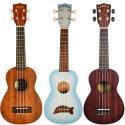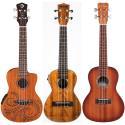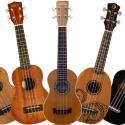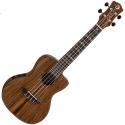All the Ukulele Parts That Make Up The Full Instrument
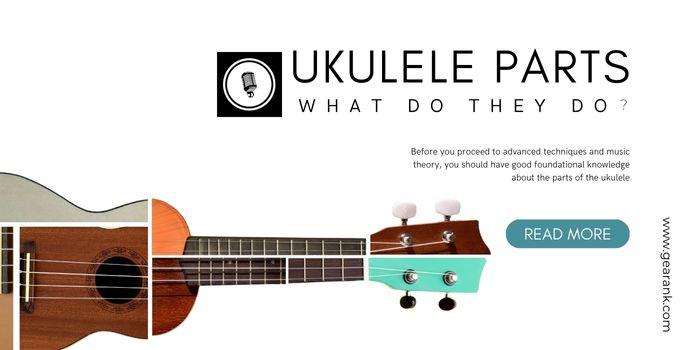
Understanding the various ukulele parts is crucial to playing the ukulele effectively.
While it is one of the most straightforward instruments to play with just four strings, you need to be familiar with each part's function, proper operation, and maintenance.
This way, you can be sure your small stringed instrument is always at its best.
So before you proceed to advanced techniques and music theory, you should have good foundational knowledge about the parts of the ukulele.
Anatomy of the Ukulele
You must take time to get to know your ukulele, especially if you are new to playing. If you are trying to learn, and someone mentions the nut, bridge, or other parts - you could feel completely lost.
There are many ukulele parts to learn about. Let's go over some of the basic parts of the ukulele in the diagram below to get you used to the instrument.
Many musicians use different names for the parts of a ukulele so we will review some of the most common ones.
The most notable parts include the headstock, tuners, nut, frets, fretboard, neck, fret markers, sound hole, body, strings, bridge, and saddle.
Parts Of The Ukulele
The ukulele is made up of a range of parts. Let's review each in more detail to familiarize you with your instrument.
The Headstock
The headstock is the wider piece that resides at the top of the neck of the ukulele. This is where you will find the tuning pegs or tuning heads. Many manufacturers will create uniquely shaped headstock to make the brand immediately recognizable.
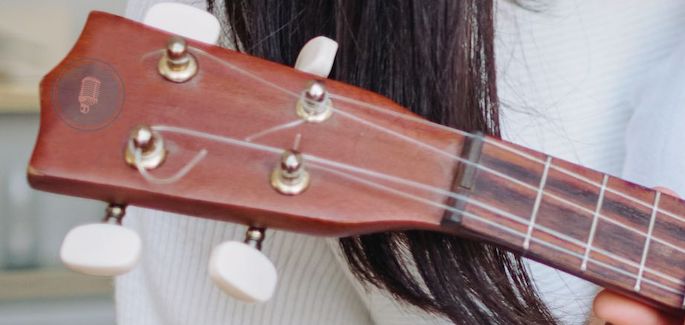
The Body
The body of the ukulele is the largest part of the ukulele. The body is most commonly made of wood, but some can be made of other materials.
The color or finish can also vary depending on aesthetic preference.
The body is the main part you cradle inside your arm when strumming.
It consists of the front piece with the sound hole, the sides, and the back portion of the ukulele.
This is where the four strings sit and is the most solid piece of the instrument. Ukulele bodies are similar to the body of a guitar, where the saddle and the bridge can be found.
The ukulele's body holds the neck, fretboard, and other parts of the instrument.
The ukulele's tone is partly dependent on the body, since the body and shape of the ukulele amplify the vibrations.
The Bridge
The bridge of the ukulele is responsible for holding the strings in place onto the body of the ukulele. This is typically glued down; you can have a tie-bar, pin, or 'through the body' bridge.
A tie-bar bridge will have tiny holes to thread the strings easily. Then, the strings need to be attached to the bridge to keep them in place.
With a 'through the body' one, the strings must be pushed through the bridge and pulled out of the sound hole.
A pin bridge needs the pin pulled out so that you can knot the string and push it through the bridge hole before returning the pin.
Saddle
The saddle is a thin piece of plastic or bone that sits on the top of the bridge. It is positioned at the base of the strings of the ukulele. The strings rest on the saddle to lift them appropriately from the fretboard and the ukulele's body.
The Neck
As you can guess, the neck is the long, thin part of wood attached to the body. This is the ukulele part above the body before you get to the headstock.
The front of the neck is flat and holds the fretboard, the underneath of the neck is more curved to make it easier to hold when playing.
The neck of a ukulele is most commonly made out of one solid piece of wood, as it needs to be sturdy and durable enough to handle the tension of the strings at all times.
Frets & Fret Markers
Frets are the small metal bars that line the fretboard. Together with fret markers, they are placed at specific intervals on the board's surface to help you find the right note.
String tension changes depending on where you press the strings on the board. This varying string tension produces the different notes you can play on a ukulele.
Frets are placed on the fretboard to mark the note changes at small semi-tonal increments. As you get closer to the ukulele's body, the space between the frets on the fretboard gets much smaller.
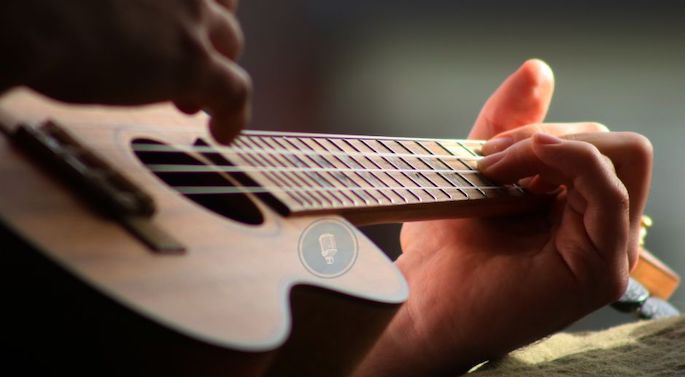
Fretboard
On the front of the neck, we have the fretboard. This is the wood part of the neck. Fretwires divide the fretboard into fret spaces, which indicate specific pitch.
Most ukuleles are twelfth frets, but other instruments have more fret space, such as the concert ukulele or a tenor ukulele, which can have 15-20 frets.
Tuning Pegs
To tune your ukulele, you need to be able to operate the specific part called pegs. The tuning pegs are the four pegs that sit at the top of the headstock. These are sometimes called machine heads or tuning keys, as they wind the string to tune it.
Each string is inserted via a small hole that keeps the string in place. When you turn the tuning pegs, the string will wrap around a metal cylinder. You turn it to either tighten strings, or loosen strings. This lets you adjust the pitch to match the appropriate tuning.
You will want to turn the pegs at specific intervals when tuning your ukulele. Try to unwind slightly before tightening strings, this will help prevent overstretching or breaking the strings. Tuning up from a lower pitch also prevents slack in the string. Slack can cause tuning issues.
A bass ukulele also has tuning pegs, albeit more stable, and able to handle the thicker strings.
Sound Hole
Sound holes are the holes on the body of the ukulele. The sound hole is where the sound reverberates inside, which is how the ukulele creates music. The sound hole is an integral part of a ukulele, and helps shape the more mellow sounds ukes are known for.
A sound hole releases the vibrations when you are playing. If you cover this hole, the ukulele will create a duller sound. If you strum your ukulele directly over the sound hole, you will make the loudest sound it can produce.
Some sound holes can have a pattern inlaid called a rosette, or they may have attractive stickers, which can make them more aesthetically pleasing.
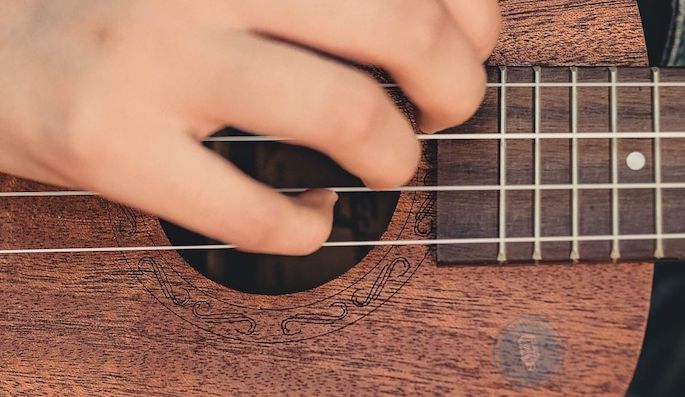
Nut
The purpose of the nut is to keep the strings apart at an equal distance. It has small ridges where each string sits. It is located at the top of the fretboard and the bottom of the headstock.
You will see small notches or grooves for each string to keep them spaced correctly. Ensuring these groves are clean can help prevent string breakages in the nut area.
Tip: You can use pencil lead shavings or graphite to lubricate the grooves for better tuning stability.
Nylon Strings Or Metal Wound Strings
The strings are what make the initial sound of a ukulele. It is stretched from headstock tuners down to the nut and saddle.
You'll mostly see 4-string ukulele models.
Most stringed instruments, like guitars, have steel strings. But ukuleles can either have nylon or metal wound low strings.
Nylon strings are what gives the common ukulele their trademark sweet and bright tune.
Speaking of strings, another important factor is the tuning used.
For example, tenor ukuleles, soprano ukuleles, and a concert ukulele would be tuned to G4, C4, E4, and A4.
Ukulele Parts Quick Guide
As a quick guide, we have a more in-depth diagram for you.
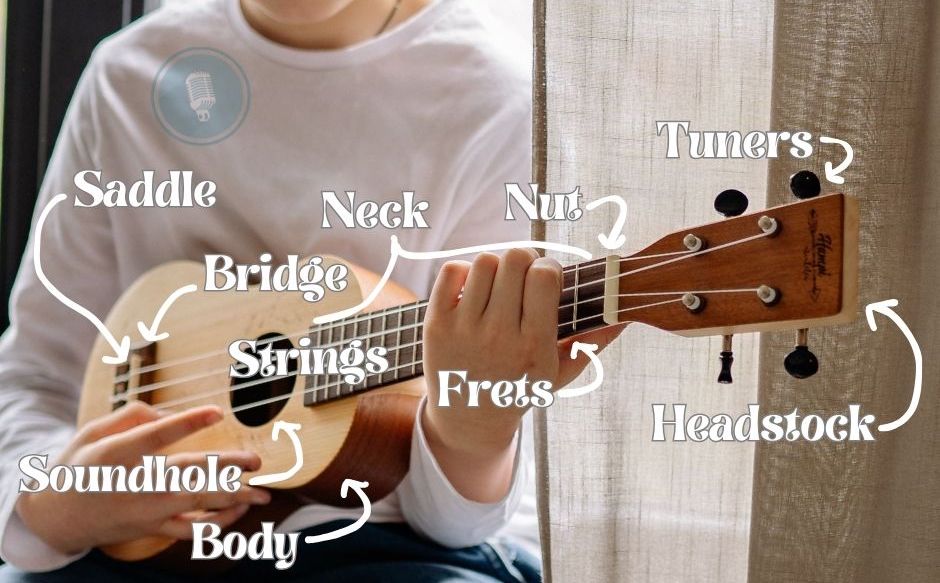
From this image, you can see clearly where the headstock, tuners, and nut are, including the neck, frets, body, bridge, saddle, strings, and sound hole.
Why Ukuleles Are One Of Our Favorite Stringed Instruments
Ukuleles are more accessible to learn than most string instruments like the guitar or mandolin, and the smaller size provides easier access and makes wrist tension less of an issue as you will not be stretching to reach the chords and strings.
Ukuleles also come in a variety of different shapes and sizes. There are the concert ukulele, baritone, bass, tenor, and soprano ukuleles - there is something for everyone!
Ukuleles are also distinct from the guitar, as they have re-entrant tuning.
This is where the strings are not tuned upwards continuously like a guitar, giving the ukulele its unique and lovely sound.
There's nothing better than plucking or strumming a simple tune, and you can quickly pick up these skills and start creating your music.
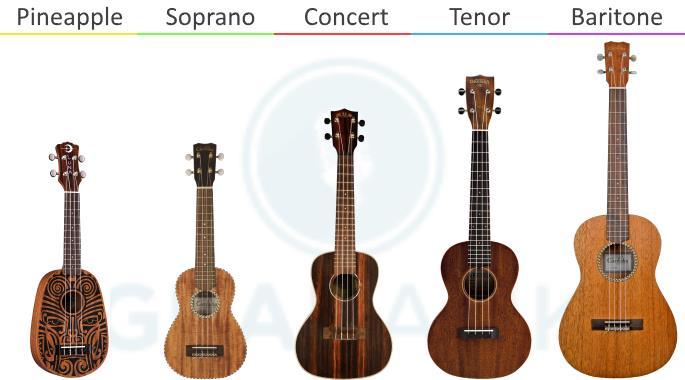
Summary
To summarize, you should know all the ukulele parts, especially if you are learning to play. This can ensure you know how to tune your uke, create a better sound, and all the notes are in key.
You can also avoid the strings becoming too tightly wound, which can risk them snapping or overstretched. Having your uke in the best working condition can ensure that you can create beautiful music.
We have covered all of the most vital parts of the ukulele, from the headstock to the strings, fret space to the body and saddle. Most ukuleles are simple to understand once you know the different pieces.
The parts are the same whether you have a tenor ukulele or other types like the concert ukulele or soprano ukulele.
Now that you have an excellent working knowledge of all the important Ukulele parts, you can keep it in the best working order.




